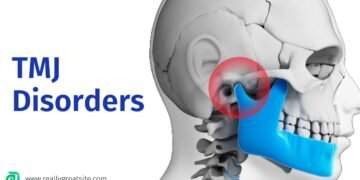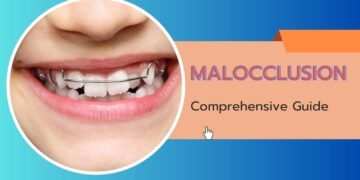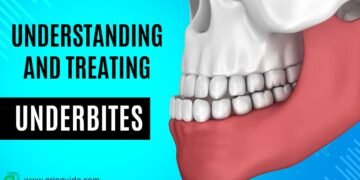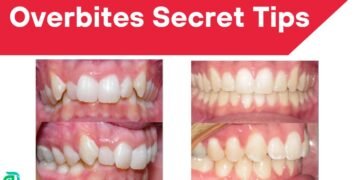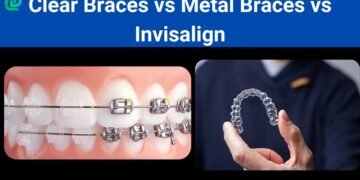Table of Contents
Introduction to Misaligned Teeth
Misaligned teeth, also known as malocclusion, refer to teeth that are not properly aligned when the jaws are closed. This common dental issue can manifest in various forms, including overbites, underbites, crossbites, and crowding. Overbites occur when the upper teeth significantly overlap the lower teeth, while underbites happen when the lower teeth protrude beyond the upper teeth. Crossbites involve one or more upper teeth biting inside the lower teeth, and crowding occurs when there is insufficient space in the jaw for all the teeth to fit normally.
Proper dental alignment is crucial for maintaining overall oral health. Misaligned teeth can lead to a range of problems, including difficulties in chewing and speaking, increased risk of tooth decay and gum disease, and excessive wear on tooth enamel. Additionally, malocclusion can contribute to temporomandibular joint disorders (TMJ), which can cause chronic pain and discomfort in the jaw, neck, and head.
This blog post aims to provide a comprehensive understanding of misaligned teeth, exploring the various types, their causes, and the potential treatments available. By delving into these aspects, readers will gain a clearer insight into the significance of addressing dental misalignment and the benefits of seeking appropriate orthodontic care. The following sections will cover the problems associated with misaligned teeth, the underlying causes, and the modern treatments that can effectively correct these dental issues.
Common Problems Caused by Misaligned Teeth
Misaligned teeth, a prevalent dental issue, can give rise to various complications affecting both oral health and overall well-being. One of the primary challenges encountered is difficulty in chewing. Irregularly positioned teeth can impede the ability to break down food efficiently, leading to digestive problems over time. Moreover, this misalignment can also interfere with clear speech, as proper articulation often relies on the correct positioning of teeth.
Beyond functional issues, misaligned teeth significantly increase the risk of tooth decay and gum disease. Crowded or crooked teeth create hard-to-reach areas that are difficult to clean effectively, allowing plaque and tartar to accumulate. This buildup can cause cavities, gingivitis, and, if left untreated, more severe periodontal diseases. Thus, maintaining oral hygiene becomes a more strenuous task for individuals with misaligned teeth.
The impact of misaligned teeth extends beyond physical health, influencing mental and emotional well-being. Individuals with noticeable dental misalignment often experience diminished self-esteem and confidence. The aesthetic aspect of a straight, aligned smile is commonly associated with beauty and professionalism, and deviations from this standard can lead to feelings of self-consciousness and social anxiety.
Additionally, dental misalignment can cause jaw pain and headaches. When teeth do not align correctly, the jaw may be forced into unnatural positions, exerting undue stress on the temporomandibular joint (TMJ). This strain can result in chronic pain, discomfort, and frequent headaches, further diminishing quality of life.
Overall, the repercussions of misaligned teeth are manifold, ranging from practical impediments in daily activities to profound psychological effects. Addressing these issues through appropriate dental intervention is crucial for fostering both oral health and general well-being.
Misaligned Teeth and Jaw Disorders
Misaligned teeth can have a profound impact on the overall health and function of the jaw. One of the primary disorders associated with dental misalignment is Temporomandibular Joint Disorder (TMJ/TMD). This condition affects the temporomandibular joints, which connect the jawbone to the skull and are essential for movements such as chewing, speaking, and yawning.
When teeth are misaligned, the uneven distribution of force during biting and chewing can place undue stress on the temporomandibular joints. This imbalance often leads to jaw pain and discomfort, manifesting in various symptoms. Common indicators of TMJ/TMD include clicking or popping sounds when opening or closing the mouth, difficulty in moving the jaw, and chronic pain that may radiate to the neck and shoulders.
The connection between misaligned teeth and jaw disorders like TMJ/TMD is rooted in the mechanics of how the jaw functions. Proper alignment ensures that the muscles, joints, and teeth work harmoniously. However, when teeth do not fit together correctly, it can alter the natural position of the jaw, leading to muscle tension and joint strain. Over time, this can exacerbate symptoms and contribute to more severe discomfort.
Additionally, individuals with misaligned teeth may experience other related issues such as headaches, earaches, and even difficulties in maintaining proper posture. The misalignment can cause compensatory behaviors, such as clenching or grinding of the teeth, which further aggravate the jaw and can lead to a cycle of pain and dysfunction.
Recognizing the link between dental misalignment and jaw disorders is crucial for seeking appropriate treatment. Addressing the root cause—misaligned teeth—can significantly alleviate the symptoms of TMJ/TMD. Treatments may include orthodontic interventions to correct the alignment, thereby restoring balance and reducing stress on the temporomandibular joints. Early diagnosis and intervention are key to preventing the progression of jaw disorders and promoting overall oral health.
Misaligned Teeth After Braces
Orthodontic treatment with braces is a widely adopted solution to correct misaligned teeth, providing patients with a more aligned and aesthetically pleasing smile. However, it is not uncommon for teeth to shift and become misaligned again after the removal of braces. Several factors contribute to this phenomenon, and understanding them is crucial for maintaining long-term dental alignment.
One of the primary reasons teeth become misaligned post-braces is the lack of retainer use. Retainers are custom-made devices designed to hold the teeth in their new positions after the braces are removed. Unfortunately, many patients either neglect to wear their retainers as instructed or discontinue their use prematurely. This oversight allows the teeth to gradually shift back towards their original positions, undoing the progress made during the orthodontic treatment.
Another significant factor is the natural shifting of teeth over time. Even after orthodontic treatment, teeth can still move due to the constant pressure exerted by daily activities such as chewing and speaking. Additionally, the aging process can alter the alignment of teeth as the jawbone and surrounding tissues change. This natural shifting underscore the importance of long-term retainer uses to counteract these changes.
Other contributing elements include wisdom teeth eruption, which can cause crowding and displacement; tongue thrusting, where the pressure of the tongue against the teeth leads to misalignment; and habits like teeth grinding or clenching, which can exert undue pressure on the teeth, causing them to move out of alignment.
To maintain alignment post-braces, it is essential to follow several key practices. Consistently wearing retainers as prescribed by your orthodontist is paramount. Regular dental check-ups can monitor any shifts in alignment and address potential issues early on. Additionally, maintaining good oral hygiene and avoiding habits that exert excessive pressure on the teeth can help sustain the results of orthodontic treatment. By adhering to these guidelines, patients can enjoy the lasting benefits of their treatment and keep their smiles beautifully aligned.
Diagnosing Misaligned Teeth
Diagnosing misaligned teeth is a multifaceted process that involves both simple and advanced diagnostic techniques. Dentists and orthodontists begin with a visual examination, carefully inspecting the alignment of the teeth and the overall bite. This initial assessment helps in identifying obvious signs of malocclusion, such as overcrowding, gaps, or irregular bite patterns.
To gain a more comprehensive understanding, dental professionals often utilize X-rays. These radiographic images provide a detailed view of the teeth, jaws, and surrounding bone structures. X-rays are crucial in detecting issues that are not visible to the naked eye, such as teeth that have not yet emerged, impacted teeth, or underlying bone abnormalities.
Further enhancing diagnostic accuracy, 3D imaging technology, such as cone-beam computed tomography (CBCT), is sometimes employed. This advanced method offers a three-dimensional view of the dental structures, allowing for precise measurement and analysis. 3D imaging is particularly beneficial in planning complex orthodontic treatments and surgical interventions.
The importance of early detection of misaligned teeth in children cannot be overstated. Regular dental check-ups starting from a young age enable early identification and intervention, which can significantly reduce the complexity and duration of treatment. Pediatric dentists and orthodontists are trained to spot early signs of malocclusion and can recommend timely corrective measures, such as interceptive orthodontics, to guide the proper development of the teeth and jaws.
For adults, consistent dental visits remain essential. Changes in tooth alignment can occur over time due to various factors, including the eruption of wisdom teeth, shifting of teeth, or other oral health issues. Routine dental examinations help in monitoring these changes and addressing any misalignment problems promptly.
In summary, diagnosing misaligned teeth is a critical step in ensuring effective treatment. Through a combination of visual examinations, X-rays, and advanced 3D imaging, dental professionals can accurately identify and plan the appropriate course of action, emphasizing the necessity of regular check-ups for both children and adults.
Misaligned Teeth Treatment
Non-surgical treatments for misaligned teeth have evolved significantly over the years, offering patients a range of effective options. Among the most commonly used methods are traditional braces, clear aligners, and various orthodontic appliances.
Traditional Braces
Traditional braces are perhaps the most recognizable treatment for misaligned teeth. They comprise metal brackets and wires that are affixed to the teeth. Over time, the orthodontist adjusts these components to gradually move the teeth into their desired positions. Typically, patients wear braces for 18 to 24 months, though the duration can vary based on the severity of the misalignment. While wearing braces, patients might experience some discomfort, especially after adjustments, but this usually subsides quickly. Regular orthodontic visits are essential to monitor progress and make necessary adjustments.
Clear Aligners
Clear aligners, such as Invisalign, offer a more discreet alternative to traditional braces. These removable, transparent trays are custom-made to fit snugly over the teeth. Patients receive a series of aligners, each designed to make slight adjustments to the position of their teeth. Typically, aligners are worn for 20 to 22 hours a day and are replaced every one to two weeks. The entire treatment duration can range from several months to a couple of years, depending on the complexity of the case. One of the primary advantages of clear aligners is their removability, allowing for easier oral hygiene and fewer dietary restrictions.

Orthodontic Appliances
Other orthodontic appliances, such as palatal expanders, retainers, and headgear, are also used to address misaligned teeth. Palatal expanders are often employed in younger patients to widen the upper jaw, making room for erupting teeth. Retainers are typically used post-treatment to maintain the new position of the teeth. Headgear, though less common, can help correct severe bite issues by applying pressure to the jaw. Each of these appliances serves a specific purpose and is selected based on the individual’s unique dental needs.
Overall, non-surgical treatments for misaligned teeth offer effective solutions tailored to the patient’s specific condition. Through careful planning and regular follow-ups, these treatments can significantly improve dental alignment and overall oral health.
Surgical Treatments for Misaligned Teeth and Jaw
In cases where traditional orthodontic treatments are insufficient, surgical interventions become a viable option for correcting misaligned teeth and jaw. One of the most common surgical procedures for severe dental and jaw misalignment is orthognathic surgery. This surgical approach is often recommended when the misalignment affects not only the teeth but also the jawbone, causing functional issues such as difficulty in chewing, speaking, or even breathing.
Orthognathic surgery involves a coordinated effort between orthodontists and maxillofacial surgeons. The process typically begins with a comprehensive evaluation, including X-rays, dental impressions, and sometimes 3D imaging, to map out the precise corrections needed. Once the preparatory orthodontic phase aligns the teeth to a certain extent, the surgical procedure can proceed. The surgery itself involves repositioning the jawbones to achieve proper alignment. This may include cutting and realigning sections of the upper jaw (maxilla), lower jaw (mandible), or both, depending on the specific needs of the patient.
Post-surgery, patients can expect a recovery period that varies depending on the extent of the procedure. Initially, there may be swelling, bruising, and discomfort, which can be managed through prescribed medication and a soft or liquid diet. Full recovery can take several weeks to a few months, during which follow-up appointments are crucial to monitor the healing process and the success of the realignment.
The benefits of surgical treatment for misaligned teeth and jaw are substantial. Beyond the aesthetic improvements, patients often experience significant enhancements in their oral functions, including better chewing efficiency, clearer speech, and improved breathing. However, like all surgical procedures, there are inherent risks, such as infection, nerve damage, and potential relapse of the misalignment. It is essential for patients to have a thorough discussion with their healthcare providers to weigh the benefits and risks before proceeding.
Overall, surgical treatments offer a robust solution for those facing severe misalignment issues, providing long-term improvements in both form and function of the oral cavity.
Preventing Misaligned Teeth
Preventing misaligned teeth is crucial for maintaining optimal oral health and ensuring a beautiful smile. Early orthodontic assessments play a significant role in identifying potential alignment issues before they become severe. Regular dental check-ups from a young age allow dentists to monitor the growth and development of teeth and jaw structures, offering timely interventions if necessary. Children should ideally have their first orthodontic evaluation by the age of seven, which can help in detecting and addressing any early signs of misalignment.
Good oral hygiene practices are foundational in preventing misaligned teeth. Daily brushing and flossing remove plaque and food particles, preventing cavities and gum disease, which can affect tooth alignment. Additionally, maintaining a balanced diet rich in nutrients supports healthy tooth and jaw development. Limiting sugary snacks and drinks can further reduce the risk of dental problems that might contribute to misalignment.
Lifestyle factors also play a crucial role in preventing misaligned teeth, especially in children. Habits such as thumb sucking and prolonged use of pacifiers can exert pressure on the teeth and jaw, leading to misalignment. Parents should encourage their children to avoid these habits and seek guidance from dental professionals if intervention is needed. Mouth breathing, often caused by allergies or nasal obstructions, can also impact the development of the jaw and teeth. Addressing underlying health issues and promoting nasal breathing are important steps in preventing misaligned teeth.
For individuals who have undergone orthodontic treatment, maintaining alignment is essential. Wearing retainers as prescribed by an orthodontist helps ensure that teeth remain in their corrected positions. Regular follow-up visits to the orthodontist for adjustments and monitoring are also important. Consistent adherence to these preventive measures can significantly reduce the likelihood of teeth shifting back to their original positions.
Incorporating these strategies into daily routines can go a long way in preventing misaligned teeth and promoting lifelong oral health. Early intervention, proper hygiene, mindful lifestyle choices, and post-treatment care are all integral components of a comprehensive approach to preventing alignment issues.
FAQs
-
What is Teeth Misalignment?
Teeth misalignment, also known as malocclusion, occurs when the teeth are not properly aligned when the jaws are closed. This can include overcrowded teeth, gaps, overbites, underbites, and crossbites. These issues can arise due to genetic factors, habits like thumb-sucking during childhood, or early loss of primary teeth.
-
How to Identify Misaligned Teeth?
Misaligned teeth can be identified through various signs and symptoms. Common indicators include difficulty in chewing or biting, speech difficulties, and visible crookedness of the teeth. Additionally, frequent biting of the inner cheeks or tongue and jaw pain can signal misalignment. A dentist can provide a definitive diagnosis through a dental examination.
-
Why It’s Important to Fix Misaligned Teeth?
Ignoring misaligned teeth can lead to several problems. Poorly aligned teeth can cause difficulty in maintaining oral hygiene, increasing the risk of tooth decay and gum disease. They can also lead to jaw strain, headaches, and difficulties in chewing and speaking. Addressing misalignment is crucial for overall oral health and well-being.
-
What are the Options to Correct Misaligned Teeth?
There are various treatment options available to fix misaligned teeth. Traditional braces are a common and effective solution, applying continuous pressure to move teeth into the correct position. Clear aligners, such as Invisalign, offer a more discreet option. In some cases, dental surgery might be necessary to correct severe misalignment. Consulting with an orthodontist will help determine the best treatment plan tailored to individual needs.

